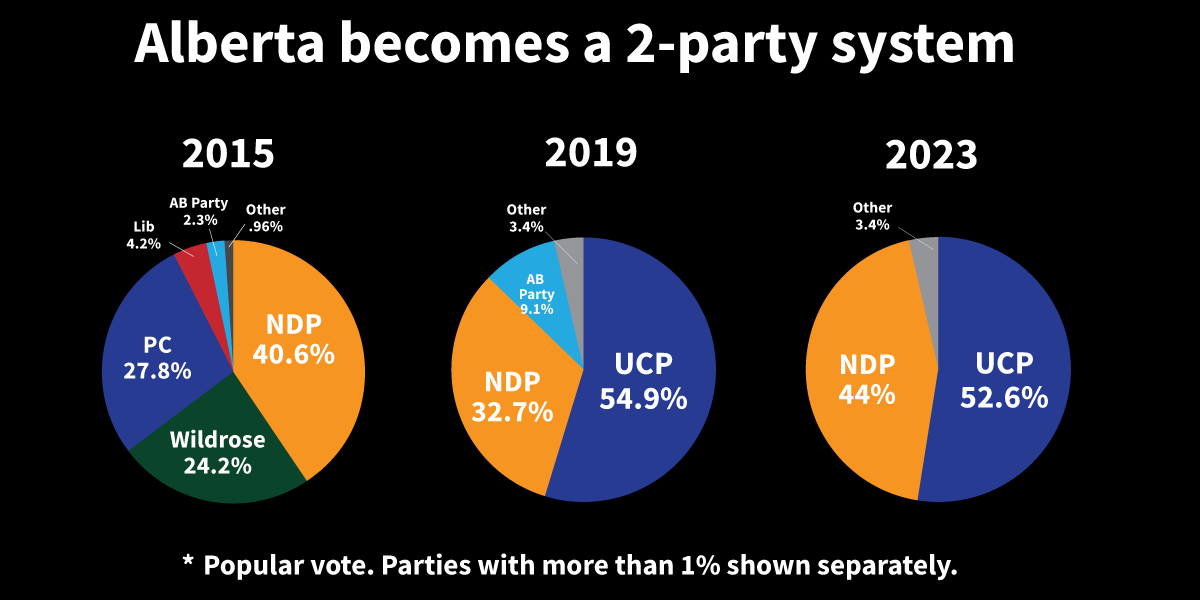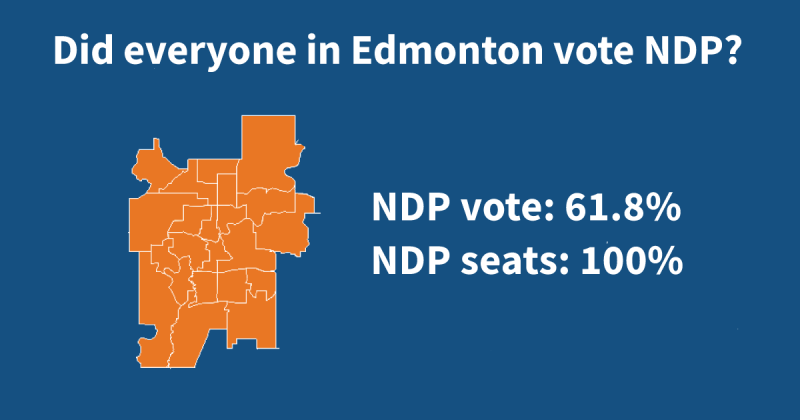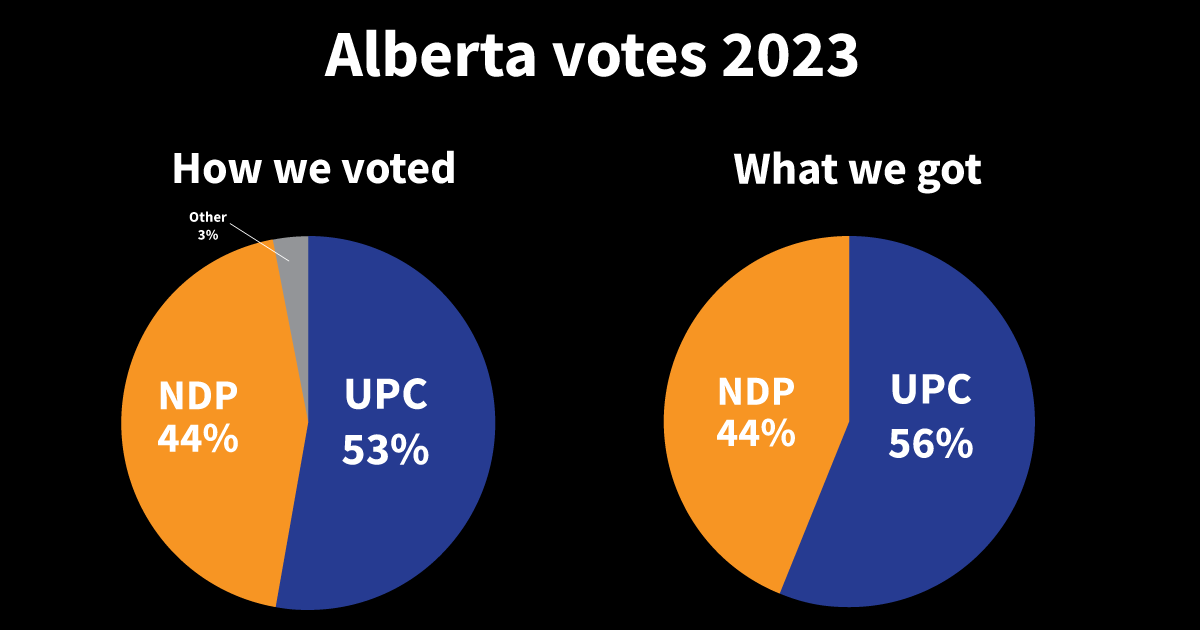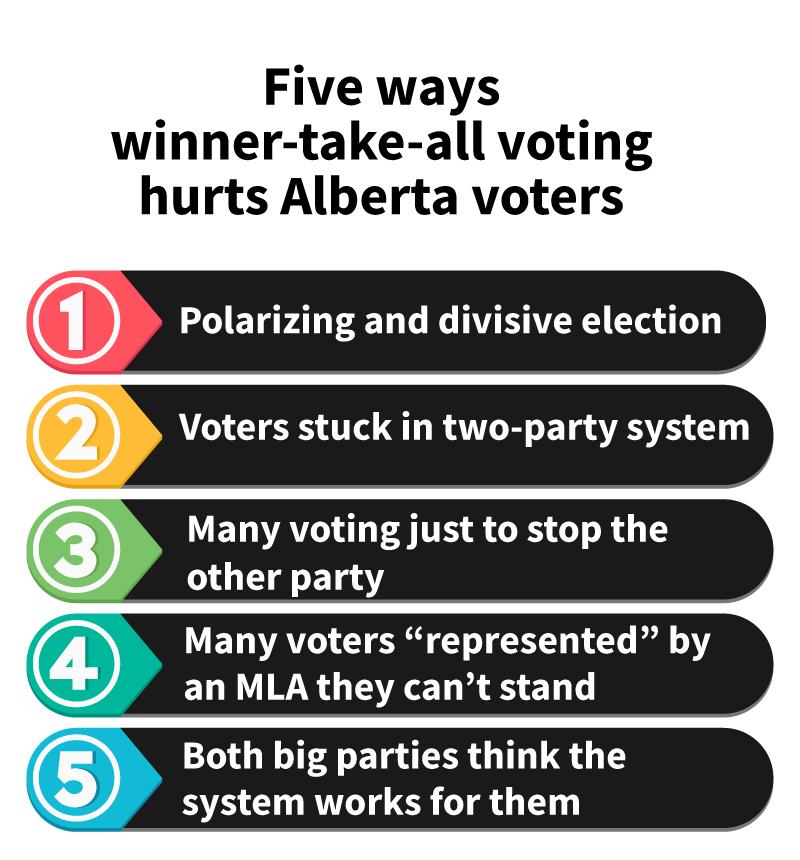
First-past-the-post has delivered an exaggerated majority for Danielle Smith’s UCP in Alberta. The party won 56% of the seats with 52.6% of the vote.
The map of the results shows exaggerated regional differences:
In the 13 ridings of Northern Alberta, UCP voters cast 67.5% of the votes but elected 100% of the MLAs. Voters for the NDP cast 29.6% of the votes but elected no one.
In the 13 ridings of Central Alberta, UCP voters cast 65.5% of the votes but elected 100% of the MLAs. Voters for the NDP cast 30.0% of the votes but elected no one.
In the 13 ridings of Southern Alberta, UCP voters cast 63.0% of the votes but elected 92% (all but one) of the MLAs. Voters for the NDP cast 33.1% of the votes but elected only one MLA.
Conversely, in the 22 Edmonton ridings, NDP voters cast 61.8% of the votes but elected 100% of the MLAs. Voters for the UCP cast 35.5% of the votes but elected no one.
Only Calgary voters saw the overall results reflect how they voted. In their 26 ridings, NDP voters cast 48.7% of the votes and elected 12 MLAs, while UCP voters cast 48.9% of the votes and elected 14 MLAs.

The more glaring observation, however, is how first-past-the-post has entrenched a two-party system.
In 2022, the Economist’s Democracy Intelligence Unit, commenting on Canada’s fall on their Democracy Index, issued a stark warning that our political problems are looking increasingly like those which have become entrenched in the United States.
Nowhere is that more apparent than in Alberta.
The stranglehold of first-past-the-post was acutely felt in a negative, divisive election campaign. First-past-the-post suppressed support for smaller parties, leaving them struggling to survive. In a polarized environment, first-past-the-post forced voters to choose between two big parties, with many voters probably motivated mainly by a desire to keep the other party out of power.
As Abacus noted in it’s May 22 report:
“The deep divide on almost every measure shows how polarized the choice in this campaign has become. NDP voters really don’t like Smith while UCP voters really don’t like Notley. Almost equal numbers think the NDP and UCP are the most risky and scary choices.”
CBC’s Vote Compass showed that one big tent does not represent the diversity of Alberta – UCP is significantly more conservative than their voters.
Opponents of proportional representation often fearmonger about “extremists” being elected. The UCP’s flip flops on how to deal with their candidate (now MLA) Jennifer Johnson, after she compared transgender children to feces, illustrates the real danger of extremists in winner-take-all systems.
The fact is, politicians with extreme views win seats with all voting systems – but their impact can differ greatly.
Winner-take-all voting systems, by forcing everyone on one side of the political spectrum into a single party, means that extremists will not only win seats, they can become cabinet ministers, or even the leader of a one-party government.
Turnout is lower when many voters feel their vote won’t count. In the 2021 federal election the turnout in Alberta was 64.4%, and in the last Alberta election it was 67.5%. But in Germany’s last election it was 76.6%, and in New Zealand’s it was 81.5%. In both countries voters had a choice of five or six parties expected to elect MPs.
The Alberta NDP supports proportional representation – on paper.
Their constitution states:
“The New Democratic Party offers an alternative vision of the future based on the following three principles: Democracy is one of the most valuable parts of our heritage and recognizes that all citizens, including minorities, must receive equal civil rights with representatives elected by way of proportional representation. Our country will only be a genuinely democratic one when all people participate fully in determining the policies of the institutions which directly affect their lives. The necessary role of governments must be recognized in order to build an equitable and socially just society.”
The Alberta NDP had Proportional Representation as a plank in their platform for the 2012 election and early in 2015, but removed it in February 2015, three months before winning their false majority.
The party had a rare window of opportunity to implement proportional representation when they formed a “majority” government in 2015, with 40.6% of the vote. Had they put voters first eight years ago and implemented PR, it’s quite possible to imagine a democracy in Alberta where several viable parties thrive, all voters have meaningful choice and fair representation, and parties work together in the legislature.
That won’t be the case so long as Alberta has first-past-the-post, which has given Albertans only two real choices.


